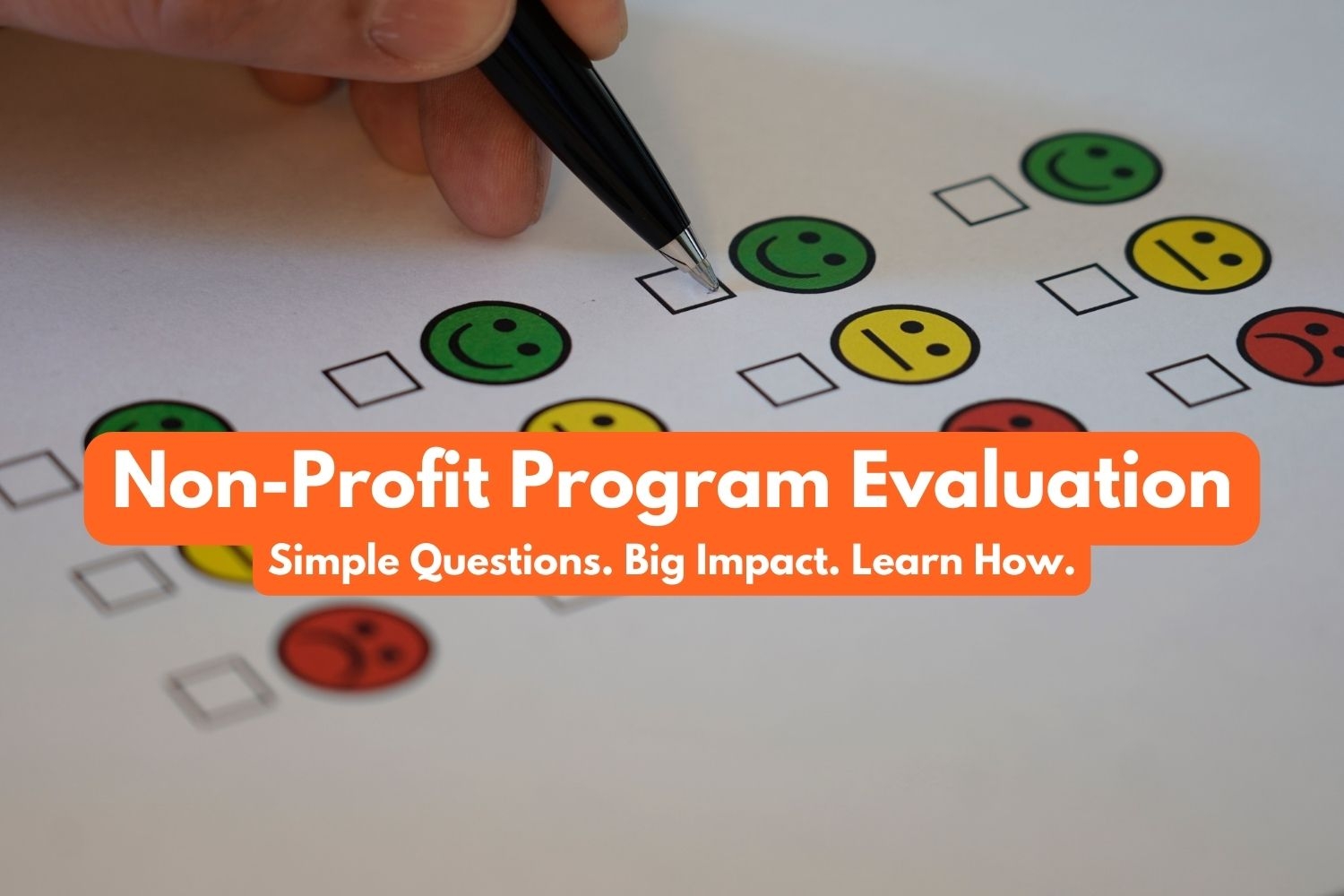Create a Program Evaluation to Gather Useable Information

Evaluation, measurement, KPIs and assessment are all part of the work of a non-profit. Feedback is collected to help determine if the organization is meeting its strategic priorities. But that flow from strategic plan to program to feedback and back around, can feel overwhelming and the creation of an evaluation form/process is often skipped. Not because it is hard, but because it feels so easy and doesn’t warrant a lot of development time.
Evaluation forms really are quite simple. They can't be too long, or participants won't complete them. That’s great news for the staffer who is tasked with creating the form. But the tricky part lies in asking the right questions. Get the evaluation wrong, and you have a bunch of information that will neither help guide future programming nor inform future strategic directions. Get the evaluation right, and you have one of the easiest collections of data to feed directly into next year's strategic planning.
Successful evaluations use everyday language.
Have you ever noticed that a funder will ask for measurement such as capacity or sustainability? If those words are used on an evaluation form, it will result in a lot of blank answers. Why? Because that's the non-profit’s internal lingo. That's not the everyday language that connects to a participant group. At the end of a program, be it a one-time workshop event, or a program that runs many months, participants have no interest in trying to decipher what the lingo means. To best connect with participants and gain the most useful feedback, use everyday language for all questions.
Successful evaluations ask strategic questions and operational questions.
Ask questions that will provide the answers to show the organization is meeting the measurements set out in the strategic plan. For example, if the strat plan identifies wanting to track a certain topic, ask questions that will provide those answers.
Ask questions that will inform how future programs are delivered. For example, if a non-profit wants to know if a certain time of day is the right choice, ask questions to provide those answers.
If a funder wants to know information that is not answered by either strategic or operational questions, those questions will need to be added.
Successful evaluations group questions to help the evaluation flow more naturally.
Start with questions that are easier for participant to answer and allow the evaluation to build into the more complex questions towards the end.
Begin with questions that are more factual because they are the easiest to answer. For example, ask how the participant first learned about the program, or what age group they belong to, or what portion of the program they attended.
After the warm-up questions ease into questions that ask the participant how they felt about their experience. For example, ask what they liked and what they disliked. These are still very easy for participants to answer but will gently guide them into providing a little more detail.
Next, ask questions that will encourage the participant to explain what they learned or experienced. For example, ask questions about how/where they will use the information they learned, or what their next step is after the program.
Finally, participants will be more invested in the evaluation at this point, and this is a good time to ask questions that are a little more complex. For example, ask participants to make suggestions for how the program could work differently, or suggestions for other participants who might find the program useful.
Successful evaluations plan for accessibility to complete an evaluation.
Keep in mind that participants will have different accessibility needs to complete the evaluation.
Online evaluation forms might be very difficult for participants with weak technology skills and might be better delivered in a hard-copy paper format. Alternately, tech-savvy participants might appreciate being able to scan a QR code and complete an evaluation right on their smart phone.
Literacy skills can play a big part in getting a completed evaluation, and verbal evaluations might be much more successful. Very younger audiences might have little ability to understand the questions in an evaluation and might respond better to selecting a happy face or a frowning face to explain their experience.
Successful evaluations plan for a fast-slow-fast-slow pace.
Nothing kills an evaluation faster then looking at two pages of long answer questions. Alternate long answer questions, with checkbox questions, with ranking questions where a selection is circled, and with multiple choice questions. Planning for a fast-slow-fast-slow pace helps to keep participants completing the evaluation right through to the end.
Successful evaluations are anonymous.
Nothing kills honest answers like having to sign a name to an evaluation form. Offer evaluations as completely anonymous unless the participant wants to provide their name. Repeat often on the evaluation, that the form is anonymous.
Successful evaluations don’t ask question they don’t need.
Every program a non-profit offers does not have to be evaluated using every question. Some questions are better suited to a workshop evaluation, some questions are better suited to a long-term program evaluation, and some questions are better suited to a year end survey. To keep evaluations short and to ensure participants complete them all the way through, don't ask questions that are not needed.
Evaluations are summarized into a program report, and then all program reports tallied into an annual report.
The program is over and there is a rather large stack of completed evaluations. Now what do you do with the information.
Once completed, evaluations are typically tallied into a summary report for that specific program. During the operating year, data from the summary report of all completed programs is reported to the board, to provide ongoing evidence that the programs and services of the non-profit are meeting the strategic priorities.
It is at the end of the operating year that the summary program reports become most valuable. All the summary reports are tallied into the final operating report for the year. This final report has two key purposes. It provides the data needed for the next year’s strategic planning. How? It provides a direct linkage to the users/clients of the non-profit and highlights common trends, challenges, and needs. That is the foundation upon which a strategic plan is built. Never again will a non-profit wonder what needs to go into the strategic plan.
Finally, it provides the information to write an amazing annual report that can be shared with everyone from clients to stakeholders, from volunteers to funders. Never again will a non-profit wonder where to find the data for that glossy annual report. Now, the path is clear.
Begin small and build over time.
The great part about using evaluations to gather feedback from a non-profit’s clients is that it is a process that can begin small and build over time. There is no need to make sweeping changes to operations to implement an evaluation system. Start by creating one evaluation for one program. When the program is over, take all the completed evaluations and tally them into a summary report. If that's as far as a non profit can go the first year that's a great step. As time permits, build more evaluations for more programs and create more summary program reports. Eventually a non-profit will have enough summary program reports to create one final year end operating report. One step at a time.
When a non profit wants to use feedback from its clients to drive future directions, thoughtfully created evaluations will build success.
Thanks for taking the time to read my ideas. If you know someone who needs to read this, why not grab the link, and share it with them. Let’s work together to create meaningful evaluations that are easy to complete and provide future-focused data.
-Christie
…
Hi, I'm Christie Saas, former board member, current Executive Director, and non-profit volunteer. I remember well, those early years when I lacked the training, the confidence, and the work-life balance to focus on becoming the best non-profit leader I could be.
Fast-forward past many bumps in the road, lessons learned, and you’ll find me still in the trenches, but a little wiser, a little calmer, and a whole lot happier. I love my work and I want to help you love yours too.
I created ChristieSaas.com so non-profit leaders never need to feel alone. I’m here to help. If you’re a brand-new non-profit leader, or a little more seasoned, someone who’s looking to make a meaningful contribution and still have time for a full life away from the job, you’re in the right place.
© Christie Saas 2022 All Rights Reserved
…
Want to learn more?
Start with one of my free resources.


